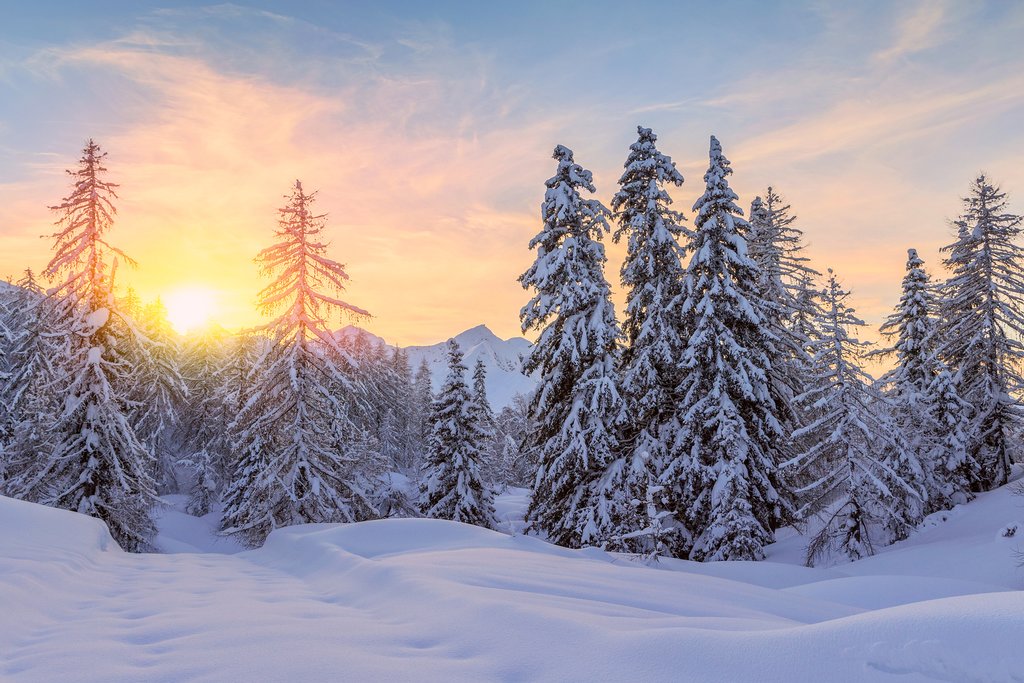Weather
The weather along the short coastline of the northern Adriatic Sea is quite mild compared to the rest of the country, with an average ranging between 37°F to 46°F (3°C–8°C). Though when the Bora winds strike, expect temperatures to drop suddenly. The cities in this region see the least amount of rainfall. However, you'll still want to pack your rain gear alongside your warm layers and winter essentials.
Heading inland toward Ljubljana, the temperatures drop a little and stay below 43°F (6°C). While the capital is one of the rainiest in all of Europe, February catches a break with only 3.5 inches (9 cm) of rainfall over nine days. Up in the high mountains is a different story, with plenty of snowfall and consistent sub-zero lows of 19°F (-7°C) and highs of 39°F (4°C).
Crowds & Costs
February is still very much offseason for much of the country, even if it is one of the busiest ski months of the year. The weather and few daylight hours make this a slower time to travel in Slovenia, and flights and hotels will be at their cheapest (with the exception of ski resorts). February kicks off the approaching spring with Mardi Gras celebrations across the country. Keeping this in mind, it's best to book reservations for accommodation and restaurants in advance.
Chat with a local specialist who can help organize your trip.
Where to Go
This small country offers much in the way of year-round culture and nature. Most travelers will begin their stay with a few days in Ljubljana—strolling along the cobblestone streets and taking in the medieval sites, art galleries, and museums. Here are some ideas for the perfect day in Ljubljana. Other historic cities worth considering are Ptuj in the east and the uncrowded coastal towns like Portorož, Piran, and Koper. Their proximity to the Karst region make for a great jumping-off point to the country's popular caves, like Škocjan and Postojna.
For snow sports and resort vibes (crackling fires, warming cocktails, and therapeutic spas), head to the mountains, Kranjska Gora attracts international and local crowds alike. Due to heavy snowfall, the Vršič Pass in the Julian Alps is likely to be closed to traffic.
Read this article for more options on the best places to visit in Slovenia.
What to Do
The days are a little longer than the month before, making this an ideal time for enjoying winter activities and cultural festivals celebrating spring's return. Hit the slopes at Kranjska Gora and stay the night in an igloo or try snowshoeing or night sledding if skiing isn't your thing. You can also take part in cross-country skiing at the Golte Ski Resort or drink a local glass of wine in an ice bar at the Kravec Ski Resort.
Photographers will want to head to Triglav National Park for stunning vistas of snow-laden peaks and forests. Lake Bohinj and Bled are particularly beautiful this time of year, having undergone a seasonal makeover. As most of Slovenia's caves are open to the public year-round and because they maintain a consistent interior temperature, February is as good a time as any to check out a few (without the hordes of tourists).
Party dwellers will be happy to know much of the country's best festivals occur in February and early March and center around Shrove and Lent in the run-up to Easter. Here's more on the best winter experiences in Slovenia.
Events in February
Kurentovanje, Ptuj. Ptuj hosts a rite of spring and fertility festival over 11 days, ending in the Kurent parades.
Pust, Cerknica. A four-day festival that sees masked partygoers and witches parade up and down the streets of Cerknica on the weekend before Ash Wednesday.
Laufarija, Cerkno. Cerkno hosts a centuries-old unique carnival welcoming in spring.
Prešeren Day, nationwide. On February 8, Slovenes celebrate Slovenian culture and the poet, France Prešeren, who died on this day in 1849.
More Helpful Information
Slovenia in January
Slovenia in March
Best Time of Year to Visit Slovenia
How Many Days to Spend in Slovenia
